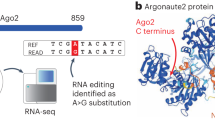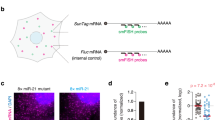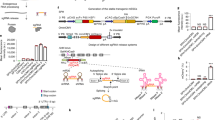Abstract
MicroRNAs (miRNAs) are short, highly conserved noncoding RNA molecules that repress gene expression in a sequence-dependent manner. We performed single-cell measurements using quantitative fluorescence microscopy and flow cytometry to monitor a target gene's protein expression in the presence and absence of regulation by miRNA. We find that although the average level of repression is modest, in agreement with previous population-based measurements, the repression among individual cells varies dramatically. In particular, we show that regulation by miRNAs establishes a threshold level of target mRNA below which protein production is highly repressed. Near this threshold, protein expression responds sensitively to target mRNA input, consistent with a mathematical model of molecular titration. These results show that miRNAs can act both as a switch and as a fine-tuner of gene expression.
This is a preview of subscription content, access via your institution
Access options
Subscribe to this journal
Receive 12 print issues and online access
$209.00 per year
only $17.42 per issue
Buy this article
- Purchase on Springer Link
- Instant access to full article PDF
Prices may be subject to local taxes which are calculated during checkout





Similar content being viewed by others
References
Lewis, B.P., Burge, C.B. & Bartel, D.P. Conserved seed pairing, often flanked by adenosines, indicates that thousands of human genes are microRNA targets. Cell 120, 15–20 (2005).
Selbach, M. et al. Widespread changes in protein synthesis induced by microRNAs. Nature 455, 58–63 (2008).
Baek, D. et al. The impact of microRNAs on protein output. Nature 455, 64–71 (2008).
Friedman, R.C., Farh, K.K., Burge, C.B. & Bartel, D.P. Most mammalian mRNAs are conserved targets of microRNAs. Genome Res. 19, 92–105 (2009).
Lim, L.P. et al. The microRNAs of Caenorhabditis elegans. Genes Dev. 17, 991–1008 (2003).
Grimson, A. et al. Early origins and evolution of microRNAs and Piwi-interacting RNAs in animals. Nature 455, 1193–1197 (2008).
Yi, R., Poy, M.N., Stoffel, M. & Fuchs, E. A skin microRNA promotes differentiation by repressing 'stemness'. Nature 452, 225–229 (2008).
Sluijter, J.P.G. et al. MicroRNA-1 and -499 regulate differentiation and proliferation in human-derived cardiomyocyte progenitor cells. Arterioscler. Thromb. Vasc. Biol. 30, 859–868 (2010).
Cimmino, A. et al. miR-15 and miR-16 induce apoptosis by targeting Bcl2. Proc. Natl. Acad. Sci. USA 102, 13944–13949 (2005).
Li, X. & Carthew, R.W. A microRNA mediates EGF receptor signaling and promotes photoreceptor differentiation in the Drosophila eye. Cell 123, 1267–1277 (2005).
Bernstein, E. et al. Dicer is essential for mouse development. Nat. Genet. 35, 215–217 (2003).
Li, X., Cassidy, J.J., Reinke, C.A., Fischboeck, S. & Carthew, R.W. A microRNA imparts robustness against environmental fluctuation during development. Cell 137, 273–282 (2009).
Li, Y., Wang, F., Lee, J.A. & Gao, F.B. MicroRNA-9a ensures the precise specification of sensory organ precursors in Drosophila. Genes Dev. 20, 2793–2805 (2006).
Bagga, S. et al. Regulation by let-7 and lin-4 miRNAs results in target mRNA degradation. Cell 122, 553–563 (2005).
Raj, A. & van Oudenaarden, A. Nature, nurture, or chance: stochastic gene expression and its consequences. Cell 135, 216–226 (2008).
Elf, J., Paulsson, J., Berg, O.G. & Ehrenberg, M. Near-critical phenomena in intracellular metabolite pools. Biophys. J. 84, 154–170 (2003).
Buchler, N. & Louis, M. Molecular titration and ultrasensitivity in regulatory networks. J. Mol. Biol. 384, 1106–1119 (2008).
Levine, E., Zhang, Z., Kuhlman, T. & Hwa, T. Quantitative characteristics of gene regulation by small RNA. PLoS Biol. 5, e229 (2007).
Ebert, M.S., Neilson, J.R. & Sharp, P.A. MicroRNA sponges: competitive inhibitors of small RNAs in mammalian cells. Nat. Methods 4, 721–726 (2007).
Calabrese, J.M., Seila, A.C., Yeo, G.W. & Sharp, P.A. RNA sequence analysis defines Dicer's role in mouse embryonic stem cells. Proc. Natl. Acad. Sci. USA 104, 18097–18102 (2007).
Ebert, M.S. & Sharp, P.A. MicroRNA sponges: progress and possibilities. RNA 16, 2043–2050 (2010).
Guo, H., Ingolia, N.T., Weissman, J.S. & Bartel, D.P. Mammalian microRNAs predominantly act to decrease target mRNA levels. Nature 466, 835–840 (2010).
Arvey, A., Larsson, E., Sander, C., Leslie, C.S. & Marks, D.S. Target mRNA abundance dilutes microRNA and siRNA activity. Mol. Syst. Biol. 6, 363 (2010).
Poliseno, L. et al. A coding-independent function of gene and pseudogene mRNAs regulates tumour biology. Nature 465, 1033–1038 (2010).
Stark, A., Brennecke, J., Bushati, N., Russell, R.B. & Cohen, S.M. Animal microRNAs confer robustness to gene expression and have a significant impact on 3′ UTR evolution. Cell 123, 1133–1146 (2005).
Farh, K.K. et al. The widespread impact of mammalian microRNAs on mRNA repression and evolution. Science 310, 1817–1821 (2005).
Tsang, J.S., Ebert, M.S. & van Oudenaarden, A. Genome-wide dissection of microRNA functions and cotargeting networks using gene set signatures. Mol. Cell 38, 140–153 (2010).
Mayr, C., Hemann, M.T. & Bartel, D.P. Disrupting the pairing between let-7 and Hmga2 enhances oncogenic transformation. Science 315, 1576–1579 (2007).
Acknowledgements
This work was supported by the US National Institutes of Health (NIH) Director's Pioneer Award to A.v.O. (1DP1OD003936) and the NIH–National Cancer Institute (NCI) Physical Sciences Oncology Center at the Massachusetts Institute of Technology (U54CA143874); and by US Public Health Service grants R01-CA133404 , R01-GM34277 from the NIH, PO1-CA42063 from the NCI (to P.A.S.) and partially by Cancer Center Support (core) grant P30-CA14051 from the NCI. M.S.E. was supported by a Howard Hughes Medical Institute Predoctoral Fellowship and a Paul and Cleo Schimmel Scholarship. G.X.Y.Z. and J.S.T. were partially supported by Natural Sciences and Engineering Research Council of Canada Post Graduate Scholarships. We thank G. Neuert for help with cloning the reporter genes, Koch Institute flow cytometry staff for training and cell sorting and D. Bartel for helpful discussions.
Author information
Authors and Affiliations
Contributions
M.S.E., J.S.T., P.A.S. and A.v.O. conceived the project. M.S.E., S.M. and G.X.Y.Z. performed the experiments. S.M. and M.S.E. processed the data and constructed the model, and S.M. quantitatively analyzed the model. S.M., M.S.E., A.v.O. and P.A.S. interpreted the results and wrote the paper.
Corresponding author
Ethics declarations
Competing interests
The authors declare no competing financial interests.
Supplementary information
Supplementary Text and Figures
Supplementary Figures 1–6, Supplementary Table 1 and Supplementary Note. (PDF 2268 kb)
Rights and permissions
About this article
Cite this article
Mukherji, S., Ebert, M., Zheng, G. et al. MicroRNAs can generate thresholds in target gene expression. Nat Genet 43, 854–859 (2011). https://doi.org/10.1038/ng.905
Received:
Accepted:
Published:
Issue Date:
DOI: https://doi.org/10.1038/ng.905
This article is cited by
-
Dual RNase activity of IRE1 as a target for anticancer therapies
Journal of Cell Communication and Signaling (2023)
-
RasGRP1 promotes the acute inflammatory response and restricts inflammation-associated cancer cell growth
Nature Communications (2022)
-
A comparative analysis of single cell small RNA sequencing data reveals heterogeneous isomiR expression and regulation
Scientific Reports (2022)
-
Pseudogenes and the associated ceRNA network as potential prognostic biomarkers for colorectal cancer
Scientific Reports (2022)
-
Dexmedetomidine Restores Autophagic Flux, Modulates Associated microRNAs and the Cholinergic Anti-inflammatory Pathway upon LPS-Treatment in Rats
Journal of Neuroimmune Pharmacology (2022)



